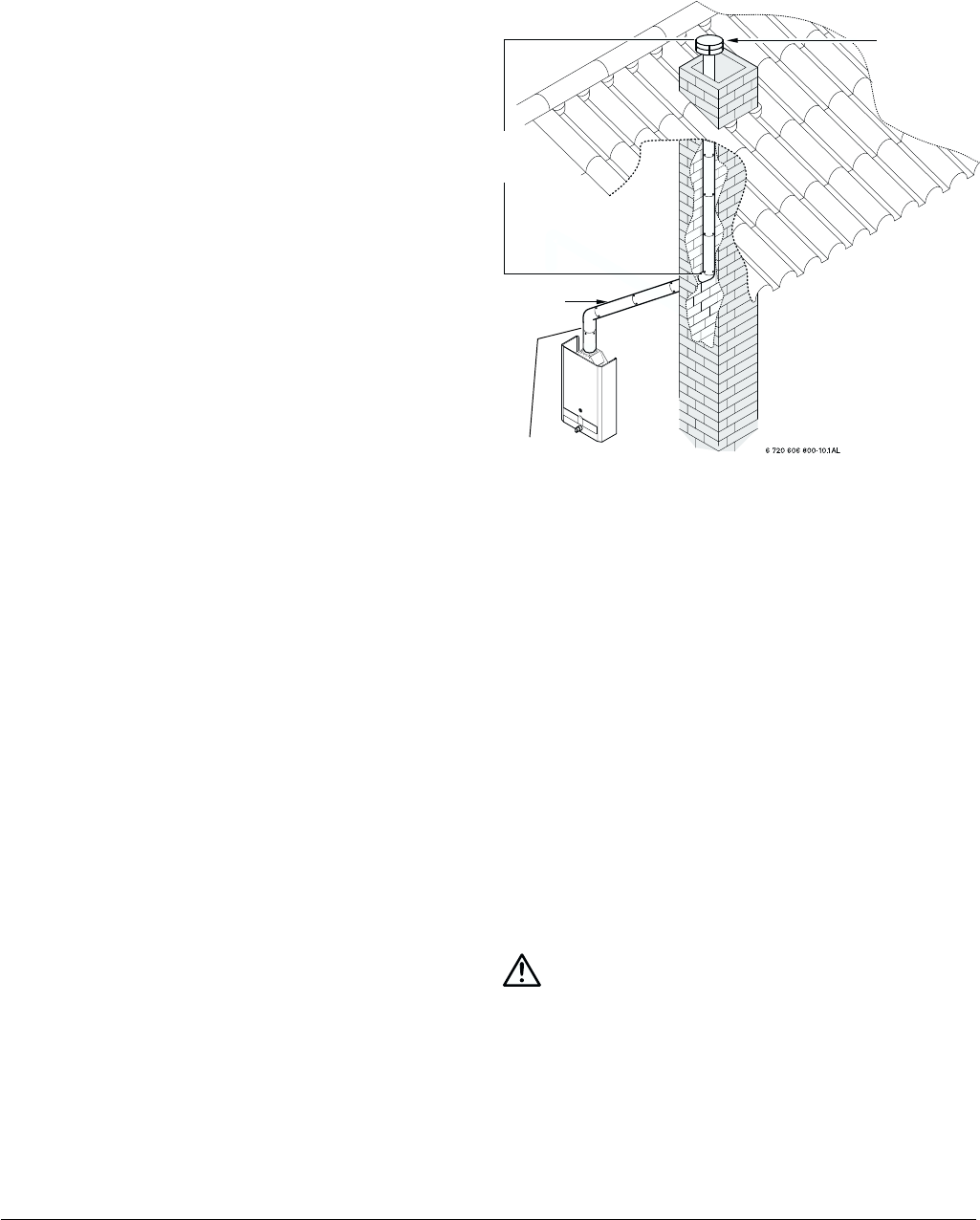
8 6 720 607 026
To check the draft:
Close all doors and windows to the outside.
Turn on all appliances that force air out of the building.
These include all exhaust/ventilation fans, furnaces, clothes
dryers, wood burning stoves, etc.
Open all doors between the 425 HN and these other
appliances.
With the control knob set fully clockwise and strong hot
water flow rate, run the unit for at least 10 minutes. The
425 HN is equipped with a Flue Gas Sensor; it’s mounted
on the right side of the draft diverter (Flue Gas Sensor #34
on page 17). If the main burners shut off during this test it
is because the Flue Gas Sensor has detected inadequate
venting. This is a serious health hazard and must be corrected.
Poor venting can result in soot building up inside the heater,
overheating of the heater and freezing of the heat exchanger
in a freezing environment, which is all a result of negative
air flow. Additional combustion air and/or improved venting
will be necessary to correct this.
WARNING
Note: The burners of an instantaneous “on demand” water
heater such as the 425 HN are only on at the time that hot
water is actually being used, the vent pipe is therefore cold
except for the short durations when hot water is being used,
it is therefore very important that the venting and air supply
be adequate to provide a good positive draft as soon as the
burners turn on.
The 425 HN instantaneous water heaters have built-in draft
diverters and are designed for indoor installation only. The
MASONRY CHIMNEYS
Gas vent
Vent
connector
Establish a one foot
rise before any elbows
Listed vent cap
Figure C
MASONRY CHIMNEY: Masonry chimneys shall be built and
installed in accordance with NFPS 211 or local codes. A
minimum 5” diameter gas vent pipe (metal double wall Type
B), or an approved clay flue liner or a listed chimney lining
system must be used when venting into a naturally drafting,
internal masonry chimney. 6 inch is required in elevations
greater than 2000 feet, see Fig. 4. Local codes may require
the use of both gas vent and an approved lining system
when venting into a masonry chimney. The Commonwealth
of Massachusetts requires the use of a listed liner. Lining
systems include approved clay flue lining, a listed chimney
lining system or other approved material that will resist
corrosion, erosion, softening, or cracking from exhaust flue
gases at temperatures up to 1800 degrees F. The lining
system must be listed for use with naturally drafting, draft
hood equipped gas appliances. Follow local codes and refer
to NFGC 54 and NFPA 58.
When connecting the water heater to a masonry chimney
the following connector guidelines must be followed for
safe and proper operation: An approved gas vent connector
must be attached to the top of the water heater and rise
vertically at least 12” before entering into an approved gas
vent connector elbow. Any gas vent section that is greater
than 45 degrees from the vertical is considered horizontal.
If a horizontal vent connector is to be used to connect the
vertical gas vent connector on the top of the water heater
to the masonry chimney, that approved horizontal gas vent
connector must be kept as short as possible and must be
sloped upwards at least ¼” per foot of its length. This
connector must be supported throughout its horizontal length.
This horizontal gas vent connection may be no greater than
75% of the total vertical gas flue vent within the chimney.
Also, an approved thimble or collar must be used when
penetrating a masonry chimney.
A) Existing INTERIOR Masonry Chimney
The metal gas vent pipe should be permanently mounted
inside the masonry chimney. Double wall Type B gas vent is
recommended. The masonry chimney may have to be tile
or metal lined before the insertion of the gas vent pipe;
check local codes for clarification. The lining material must
be listed for use only with naturally drafting, draft hood
equipped gas appliances. Follow manufactures instructions
for installation of listed lining material. You may not vent any
other fuel burning appliances into any free space remaining
in the chimney. The minimum vertical gas vent length within
the masonry chimney should be no less than 5 ft (1.5 m);
the vent terminator should extend at least 3 feet (0.9 m)
above where the chimney meets the roofline and at least 2
feet (0.6 m) higher than any vertical wall or similar obstruction
within 10 feet (3.1 m). The top of the gas vent should have
an approved vent terminator. See Figure C.
B) Tile Lined INTERIOR Masonry Chimney
The masonry chimney must have an approved liner, ceramic
tile, clay or metal. The masonry chimney must be able to
accommodate the spent fuel gasses; consult a venting
HVAC contractor for chimney capacity. A common venting
like-fuel appliance into this lined masonry chimney is
permissible. The chimney’s diameter must be large enough
to adequately draft the spent fuel gasses. A venting HVAC
contractor will be required to spec a chimney system. The
minimum vertical chimney length should be no less than 5
ft (1.5 m); the termination point should extend at least 3
feet (0.9 m) above where the chimney meets the roofline
and at least 2 feet (0.6 m) higher than any vertical wall or
similar obstruction within 10 feet (3.1 m). See Figure C.
C) EXTERIOR masonry Chimney
Refer to the National Fuel Gas Code and consult a local
venting HVAC contractor.


















